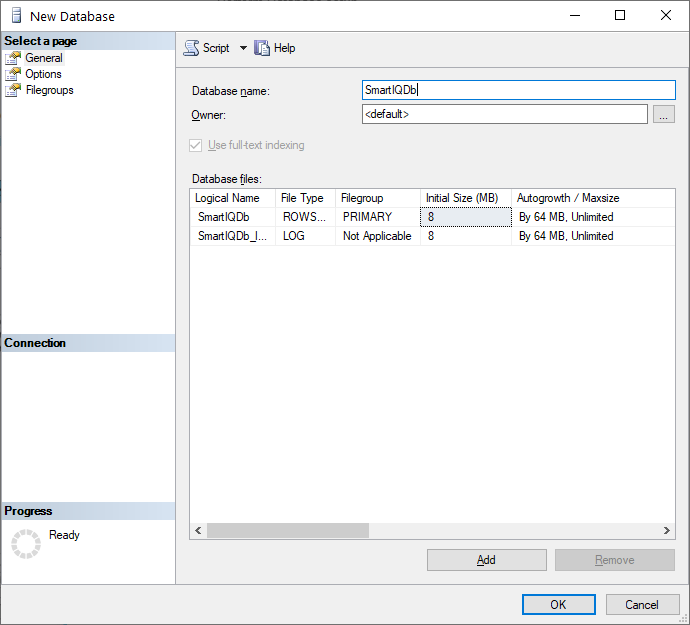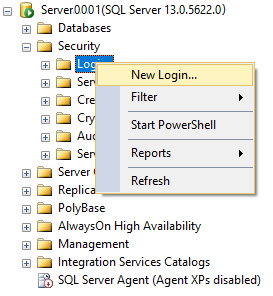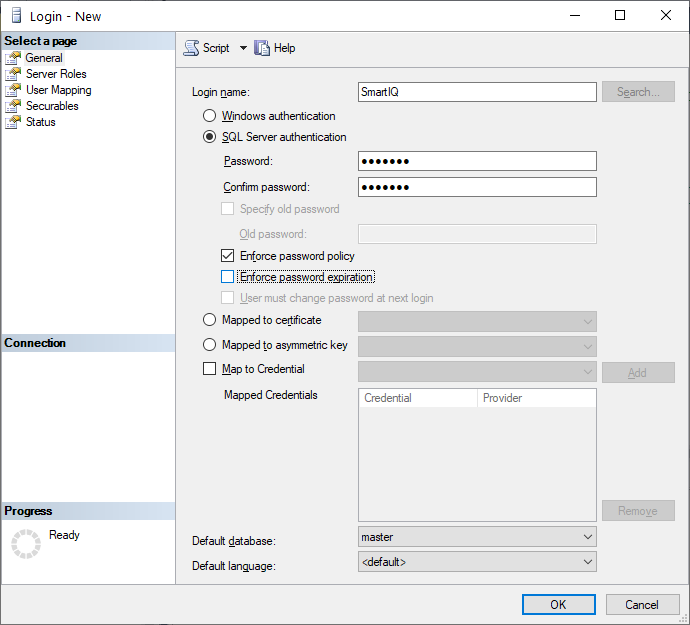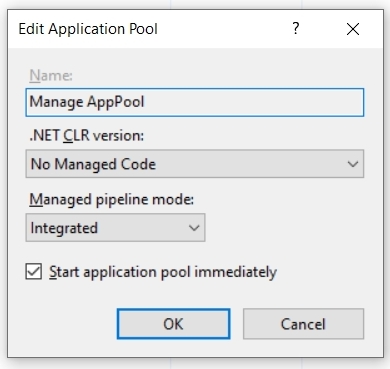Step by step
This chapter takes you through setting up and configuring the SmartIQ web applications – Produce and Manage. If you are looking for installation instructions for 'SmartIQ Scheduler' please refer to the page Installing Scheduler.
How to follow the guideEach section consists of two sub-sections. The background subsection provides objectives and background knowledge related to the section. The instructions subsection provides explicit steps that you will need to follow.
Perform Database setup
The base level of services in the SmartIQ system architecture is provided by a database layer. The database stores projects and their logic, reusable content as well as security information and settings.
This section guides you through the process of attaching a new SmartIQ database and preparing it for use by the SmartIQ system.
These steps include:
- Enable the TCP/IP and SQL Browser
- Create the database
- Create the database login
Database Configuration InstructionsThe following instructions are based on the MSDN documentation provided by Microsoft and are targeted towards SQL Server 2014. If you are using a different version, some steps may vary.
For more information on attaching the SmartIQ database or for specific instructions relating to your SQL Server version refer to the MSDN Library. https://msdn.microsoft.com/en-us/library/default.aspx
Setting up the SQL Server Browser
SQL Server Browser is a Windows Service that must be running in order for the SQL instance to be discoverable from another network location.
-
Launch the SQL Server Configuration Manager application.
-
In the left pane, click to select SQL Server Services.
There may be a number of services installed depending on the SQL Server type and configuration. One of these services should be ‘SQL Server Browser’.
- Right-click the ‘SQL Server Browser’ service, and select Properties from the pop-up menu.
The SQL Server Browser Properties dialog displays.
-
On the Service tab, change the property Start Mode to ‘Automatic’.
-
Click OK.
-
Right-click the ‘SQL Server Browser’ service again, and select Start from the pop-up menu. This will start the service running immediately without requiring a reboot.
Enabling TCP/IP for SQL Native Client 11.0 Configuration
-
Launch the SQL Server Configuration Manager application.
-
In the left pane, click to select SQL Native Client 11.0 Configuration -> Client Protocols.
-
Right-click the ‘TCP/IP’ protocol and select Enable on the pop-up menu.
A warning message displays informing you that the change won’t take effect until you restart the SQL Server service. Ignore this warning for the time being as we are going to do a restart of SQL Server services at a later stage. -
Click OK.
Enabling TCP/IP for SQL Server Network Configuration
-
Launch the SQL Server Configuration Manager application.
-
In the left pane, click to select SQL Server Network Configuration -> Protocols for MSSQLSERVER.
-
Right-click the ‘TCP/IP’ protocol and select Enable on the pop-up menu.
A warning message displays informing you that the change won’t take effect until you restart the SQL Server service. -
Click OK.
Restarting the SQL Server Service
- In the left pane, click to select SQL Server Services.
- Right-click the ‘SQL Server (instance)’ service for the appropriate instance of SQL Server, and select Restart from the pop-up menu. Configuration is complete once the service has successfully restarted.
Enabling Mixed Mode Authentication
-
Launch the SQL Server Management Studio application and connect to the target SQL Server instance.
-
In the Object Explorer pane, right-click the server instance root node.
-
Select Properties from the pop-up menu.
-
Select the Security page.
-
In the Server authentication area, select the ‘SQL Server and Windows Authentication mode’ option.
Creating the Database
-
Launch SQL Server Management Studio and connect to the target SQL Server instance.
-
In the Object Explorer pane, expand the instance root node, then right-click the ‘Databases’ node and select New Database.
The New Database dialog is displayed.
- Specify the name of the database you intend to use for the SmartIQ database. Leave the owner as default as we will specify this in a later step once the user is created.

- Click OK to create the database.
Creating the Database Login
The SmartIQ platform requires two (2) logins with different privileges:
- A login with db_owner role memberships for modifications to the database schema when performing upgrades
- A non-elevated login for regular read/write operations
Creating the db_owner login
-
Launch SQL Server Management Studio and connect to the target SQL Server instance.
-
In the Object Explorer pane, expand the instance root node, then right-click the ‘Login’ node under Security and select New Login. The Login - New dialog is displayed.

-
On the General page, enter a Login name, for example "SmartIQDbOwner" and select SQL Server authentication.
-
Enter a valid password in the Password and Confirm password text boxes.
-
As this is a system level account, it’s advisable to uncheck the Enforce password policy check box to remove password expiration. This is because if the password expires then the application will stop working.
-
Select the User Mapping page in the left pane.
-
Find the SmartIQ database attached earlier, and place a check in the Map column for the database.
-
Click into the Default Schema column and type ‘dbo’.
-
In the Database role membership for: (DB name) list, place a tick against the ‘db_owner’ role.
-
Click OK.
Creating the regular user (no extra role membership)
-
Launch SQL Server Management Studio and connect to the target SQL Server instance.
-
In the Object Explorer pane, expand the instance root node, then right-click the ‘Login’ node under Security and select New Login. The Login - New dialog is displayed.
-
On the General page, enter a Login name, for example "SmartIQ" and select SQL Server authentication.

-
Enter a valid password in the Password and Confirm password text boxes.
-
Select the User Mapping page in the left pane.
-
Find the SmartIQ database attached earlier, and place a check in the Map column for the database.
-
Click OK.
Run Installer
The SmartIQ.{version}.install.exe file is used for installation and upgrade wherein it will determine if there is an existing installation in the selected installation folder. If none, it will treat the installation as a new install. If there is an existing installation, the setup package will continue as an upgrade.
The setup package is used to set up the required directory structure and copy the SmartIQ web application files onto the web server. The package will also configure an initial setup using Forms Authentication.
Additionally, for a new installation, the package will also provide the option to enter connection string details for the SmartIQ database.
After running the setup package, the websites need to be configured in Internet Information Service (IIS) Manager.
Authentication modeThe setup process initially configures SmartIQ for Forms Authentication (username/password access) using default credentials. It is best practice to complete the setup and test the sites using this configuration before attempting to change authentication mode to make it easier to configure permissions and groups using the default administrator account that may be required for another authentication mode. More information on authentication can be found from the documents in Authentication folder.
Installation Instructions
- Before you begin installation, ensure you have a copy of the SmartIQ.{version}.install.exe file. This file configures a new or additional instance of SmartIQ as well as upgrade an existing instance.
You can request a short term license key prior to installation from support. You will need either a short term key or allow time to contact support for a permanent key once the software is running.
-
Execute the SmartIQ.{version}.install.exe file.
The destination folder page is displayed. -
Accept the default destination folder, or click Browse to choose an alternative. This guide assumes the default of
C:\inetpub\wwwroot\<productname>is chosen. -
Click Next to continue. The database settings page is displayed.
-
Specify the server name or the IP address of the server that will be running the SmartIQ database as well as the database user credentials.
DBO is the user that will be used for the upgrades. The second set of credentials is used for general connections. -
Click Finish to finish installation.
Configure IIS
NoteEnsure that the minimum IIS version/components required for the install are present before attempting to configure the SmartIQ Produce and Manage Applications.
Once the SmartIQ files and folders have been prepared using one of the techniques described above, you are ready to configure IIS to make the SmartIQ Produce and Manage web applications available to end users.
The process of configuring IIS involves:
- Create separate Application Pools for each application
- Add the SmartIQ Manage application
- Add the SmartIQ Produce application
Creating separate Application Pools for each application
Each Application Pool runs in its own Windows process, allowing you to isolate different applications on the IIS web server to ensure they use their own resources. The SmartIQ platform requires separate Application Pools for the Manage and Produce applications.
-
Launch the Internet Information Services (IIS) Manager application.
-
In the left pane, expand the tree so you can see the ‘Application Pools’ node.
-
Right-click the ‘Application Pools’ node and select Add Application Pool… from the pop-up menu.
The Add Application Pool dialog displays.

-
Enter a name for the new application pool, e.g. ‘SmartIQAppPool’.
-
Ensure that the .NET CLR version selected is ‘No Managed Code’, and that the Managed pipeline mode is set to ‘Integrated’.

-
Click OK.
-
Repeat the steps above to configure a Produce Application Pool.
Adding the SmartIQ Manage Application
NoteThe SmartIQ Manage application must be installed, launched with license keys configured before attempting to install the SmartIQ Produce Application.
These instructions assume that the SmartIQ Manage application will be created within the Default Web Site on the web server. For more advanced bindings, you may need to create a new site for your SmartIQ deployment and substitute ‘Default Web Site’ for your site in these instructions.
-
In Internet Information Services (IIS) Manager, expand the server node to the site you wish to use, typically ‘Default Web Site’.
-
Find the directory with the name Manage and right click.
-
Select convert to the application and select the configured Manage Application Pool.
-
Click OK.
Best PracticeIt is recommended that you test your application and license before and after adding the produce application to ensure that they are working as intended.
Add the SmartIQ Produce Application
These instructions assume the SmartIQ produce application will be created within the Default Web Site on the web server. For more advanced bindings, you may need to create a new site for your SmartIQ deployment and substitute ‘Default Web Site’ for your site in these instructions.
-
In Internet Information Services (IIS) Manager, expand the server node to the site you wish to use, typically ‘Default Web Site’.
-
Find the Node with the name
Produceand right click. -
Select convert to the application and select application pool
-
Click OK.
Installing in Non-Default LocationIf you installed SmartIQ outside of IIS document root you will need to add the site to IIS. This can be done by right clicking on top of site node (typically 'Default Website') and selecting add application.
Updated 8 months ago
